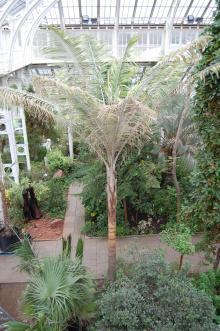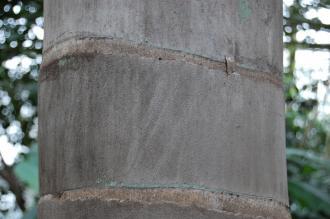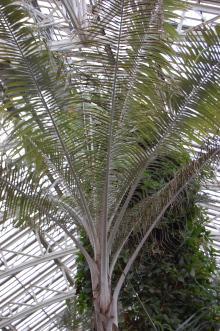
Ceroxylon quindiuense (09/02/2013, Kew Gardens, London)
Position: Full sun to light shade
Flowering period: Not known
Soil: Moist, well drained
Eventual Height: 50m
Eventual Spread: 6m
Hardiness: 10a – 12
Family: Arecaceae
Ceroxylon quindiuense is a slow growing, evergreen palm tree. Its dark green/ gray leaves are pinnate with up to 250 leaflets, arching and up to 3.5m long. Its branches. Its trunk may achieve a diaameter of up to 60cm. Its bark is smooth, has a waxy finish with dark rings left by fallen leaves. Its flowers are dioecious. Its red fruit appear in clusters.
Ceroxylon quindiuense, commonly known as Quindio Wax Palm, Andean Wax Palm or Palma de cera del quindio, is native to mountainous regions of Colombia. This palm is the national tree of Colombia. It is the tallest recorded palm and monocot in the world. The wax on the trunk of this palm was used to produce soap and candles. As a consequence this palm is classified as Vulnerable according to the IUCN Red List of Threatened Species.

Ceroxylon quindiuense Bark (09/02/2013, Kew Gardens, London)
The etymological root of the binomial name Ceroxylon is derived from the Latin Cero meaning ‘coat with wax’ and xulon meaning ‘timber’. Quindiuense is derive from the region from where this palm is indigenous, Quindio, Colombia.
The landscape architect may find Ceroxylon quindiuense useful as an ornamental palm tree. It will not tolerate high temperatures and prefers a humid atmosphere.

Ceroxylon quindiuense Leaf (09/02/2013, Kew Gardens, London)
Ecologically, Ceroxylon quindiuense, in its native habitat, provide valuable habitat and food for a number of endangered species. Birds and mammals are attracted to its fruit.
Ceroxylon quindiuense prefers moist, humus rich, well-drained soils. It prefers an acidic to neutral pH of soil.
Ceroxylon quindiuense requires little maintenance.

